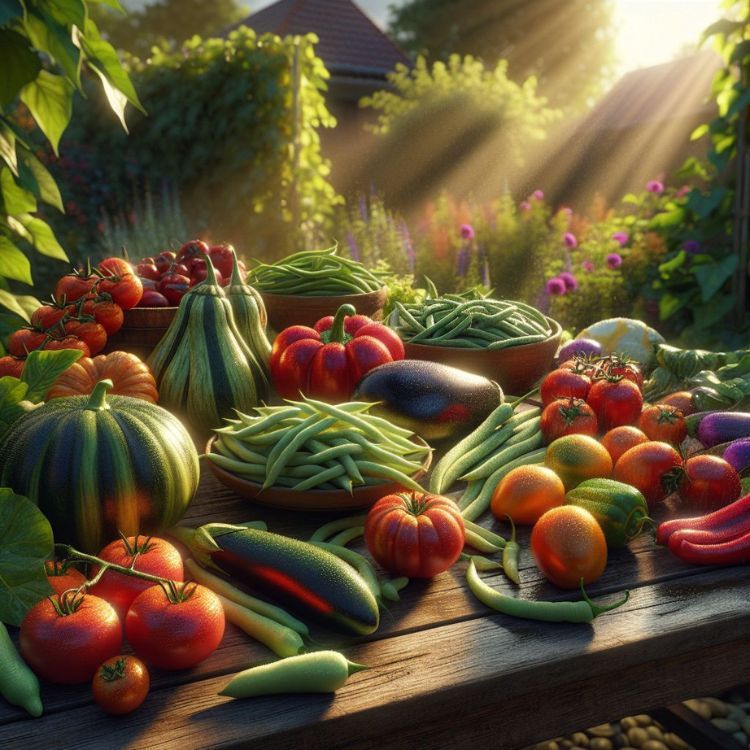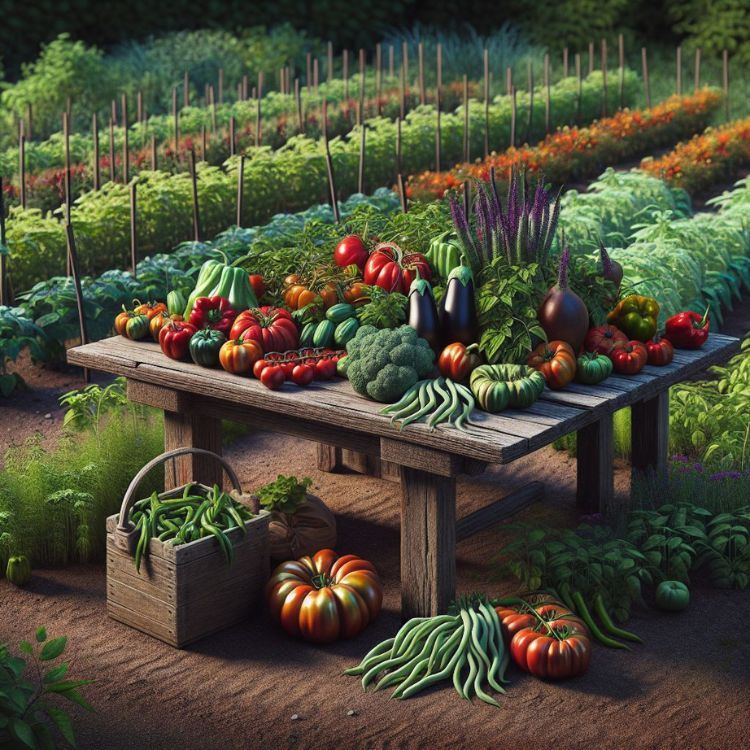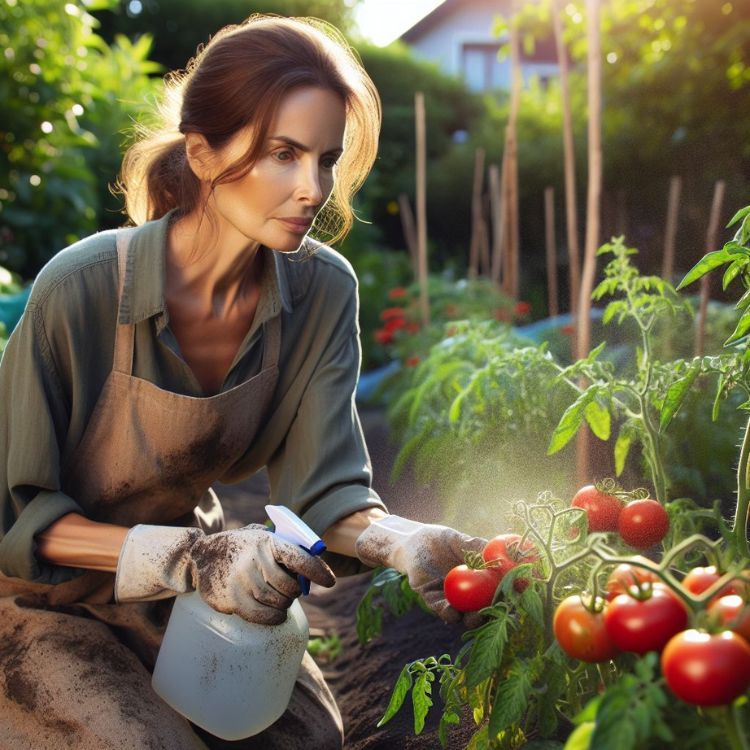
Key Takeaways
-
Drought-resistant vegetables like tomatoes, peppers, and eggplants save water and thrive in arid climates.
-
Preparing soil with organic matter and using mulching techniques can enhance the resilience of your garden.
-
Companion planting creates microclimates and helps with water conservation, making it a smart strategy in dry conditions.
-
Pest management in drought-resistant gardens can be achieved with the help of beneficial insects and organic pesticides.
-
Regular, well-timed watering is essential for the initial establishment of drought-resistant plants, even if they can later tolerate dry spells.
Gearing Up for Growth: Selecting Drought-Resistant Veggies
When you’re faced with a dry climate and water restrictions, the right choice of vegetables can make or break your garden. Let’s talk about gearing up for growth with veggies that can take the heat and thrive with less water. Because when it comes to gardening, the smart choice is not only what you plant but how you nurture it.
Advantages of Planting Drought-Resistant Varieties
Choosing drought-resistant vegetables comes with a host of benefits. They’re tough, they demand less from our precious water resources, and they can produce bountiful harvests even when the rain doesn’t fall as often as we’d like. Most importantly, they encourage us to adapt to our environment and contribute to a sustainable future.
Understanding Plant Adaptations to Arid Environments
Before we dive into the specifics, let’s understand why some plants do better with less water. Drought-resistant veggies typically have deep root systems to tap into moisture that’s way down in the soil. They’re also champions at storing water or reducing water loss through their leaves. It’s these clever adaptations that make them ideal for arid conditions.
Thirst-Quenching Champions: Top Drought-Resistant Vegetables

1. Tomatoes: Sun-Loving and Water-Saving
Tomatoes are a garden favorite, and it’s no wonder they’re a top pick for dry climates. They love the sun, and once established, they can tolerate quite a bit of drought. Just remember, while they can handle some neglect, a consistent watering schedule helps them develop those juicy, flavorful fruits we all love.
2. Peppers: Spicing Up Your Garden with Less Water
Peppers, both sweet and spicy, are also well-suited for hot, dry gardens. They’re not just about adding a kick to your dishes; they’re about bringing color and life to your garden with minimal water use. And the variety! From bell peppers to jalapeños, you can choose what excites your palate and your gardening spirit.
3. Eggplants: Hardy Picks for the Heat
Eggplants are the unsung heroes of the drought-tolerant garden. They’re robust, they love the warmth, and they have a beautiful, almost whimsical look with their deep purple fruits hanging amongst the green leaves. They’re a testament to the fact that even in dry conditions, your garden can be both functional and beautiful.
4. Beans: Minimal Water for Maximum Protein
Beans are not just a staple food; they’re a staple in the water-wise garden. They grow quickly, provide an excellent source of protein, and once they’ve settled in, they don’t ask for much water. It’s this efficiency that makes them a smart choice for your resilient garden.
5. Squash: Bountiful Harvests in Sparse Conditions
And let’s not forget about squash. Whether it’s zucchini, butternut, or acorn, these plants are vigorous growers and can produce an abundance of food with relatively little water. They’re proof that even when the environment is challenging, your garden can still be a place of abundance.
Rooted in Resilience: Preparing Your Patch for Drought-Resistant Crops
Now, let’s talk soil. The foundation of any good garden is its soil, and this is especially true when you’re working with less water. You want to start with soil that’s rich in organic matter. This helps it retain moisture and provides nutrients for your plants. Consider adding compost or well-rotted manure to give your veggies a good start.
Mulching is another key strategy. By covering the soil with organic mulch like straw or wood chips, you can significantly reduce water evaporation. This means your plants will have access to moisture for longer periods, and you’ll be watering less frequently. It’s a simple step, but it makes a world of difference.
And don’t forget about watering wisely. Even drought-resistant plants need a good drink when they’re first getting established. The trick is to water deeply but infrequently, encouraging those roots to grow deep into the soil where they can access moisture even when the surface is dry. A drip irrigation system is a great investment here, as it delivers water right to the roots with minimal waste.
Example: A gardener in a dry region starts a new vegetable patch with drought-resistant plants. They add compost to the soil, apply a thick layer of mulch, and install a drip irrigation system. Even in the height of summer, their garden thrives with minimal additional watering.
Soil Amendments for Water Retention
Let’s get our hands dirty and beef up that soil! Good soil is like a sponge; it soaks up water and holds onto it for when plants get thirsty. To make your soil more sponge-like, mix in plenty of organic matter. This can be compost, leaf mold, or well-aged manure. It’s not just about water; this organic gold also feeds your plants as it slowly breaks down.
Mulching Methods to Minimize Moisture Loss
Mulching is your garden’s best friend, especially when water is scarce. It’s like a blanket for your soil, keeping it cool and moist. Here’s what you can do:
-
Spread a layer of organic mulch, like straw or wood chips, around your plants.
-
Make sure the mulch is a few inches thick to effectively retain moisture.
-
Remember to keep the mulch away from plant stems to prevent rot.
Mulching not only conserves water but also suppresses weeds, which compete with your veggies for moisture. It’s a win-win! For more detailed techniques on weed and pest control without toxins, check out our guide.
Another tip is to use living mulches—low-growing plants like clover that cover the soil. They keep the ground cool and share their space with your veggies without hogging all the water.
The Role of Well-Timed Watering
Watering is all about timing. The best time to water is early in the morning or late in the afternoon when the sun won’t evaporate all your hard work. And remember, a deep soak a couple of times a week is better than a sprinkle every day. This encourages roots to grow deep and strong, seeking out moisture below the surface.
Plant Allies: Companion Planting for Drought Conditions
Companion planting is like matchmaking for your garden. Some plants just get along well and help each other out. They can provide shade, repel pests, or even help improve the soil. In a dry garden, companion planting is a smart way to make the most of every drop of water.
Companions for Tomatoes
Tomatoes love having basil as a neighbor—it’s said to make them taste even better. Marigolds are also great buddies for tomatoes; they repel nematodes and other pests that could stress out your tomatoes. Here’s how to pair them:
-
Plant basil between your tomato plants for a flavorful boost.
-
Edge your tomato patch with marigolds to keep the pests at bay.
Water-Wise Friends for Peppers and Eggplants
Peppers and eggplants enjoy the company of onions and spinach. Onions can deter pests, while spinach provides a living mulch, keeping the soil moist for its companions. Here’s a simple layout:
-
Plant onions around the perimeter of your peppers and eggplants.
-
Sow spinach seeds in the spaces in between to act as a ground cover.
Nurturing Neighbors for Beans and Squash
Beans fix nitrogen in the soil, which is a boon for hungry squash plants. And when squash’s big leaves spread out, they shade the soil, helping it stay moist for the benefit of both plants. To make this partnership work:
-
Plant beans at the base of your squash plants.
-
Let the beans climb and the squash sprawl for a happy garden duo.
By choosing the right companions, you’re creating a mini-ecosystem where plants support each other, making your garden more resilient and less thirsty. For more insights on optimizing your garden space, check out our guide on essential urban gardening tools & accessories.
Natural Defenders: Pest Management in Low-Water Gardens

Pests can be a real headache in any garden, but in a drought
By fostering a garden with drought-resistant vegetables, you’re not just growing food; you’re cultivating resilience. Pests, however, can be particularly challenging in these conditions. They often become more concentrated and aggressive when water is scarce, as both plants and pests vie for the limited resources. But fear not, because nature has a balance of its own.
Attracting beneficial insects is a natural and effective way to keep pests in check. Ladybugs, lacewings, and praying mantises are like the guardians of your garden, munching on aphids, mites, and other small pests that could otherwise wreak havoc on your plants. You can encourage these helpful critters to take up residence by planting flowers like marigolds and sunflowers, or by avoiding broad-spectrum pesticides that can harm them.
When it comes to pesticides, the best approach in a drought-resistant garden is to use organic options sparingly. Neem oil, insecticidal soaps, and diatomaceous earth can target specific pests without causing widespread damage to the beneficial insect populations. Always follow the directions carefully, because the goal is to manage pests, not to create a toxic environment for your plants.
Frequently Asked Questions
Can drought-resistant vegetables survive without any watering?
While drought-resistant vegetables are tough, they do need water, especially during the critical phases of germination and early growth. Once established, they can endure longer periods without water, but a well-timed soak during extended dry spells will keep them producing and thriving.
How often should I water my drought-resistant vegetable garden?
It’s not just about frequency; it’s about how you water. Early morning or late afternoon is best to reduce evaporation. A deep soak that reaches the roots a couple of times a week is preferable to daily light sprinkles. This encourages deeper root growth and reduces water waste.
What mulch materials are best for conserving water in the garden?
Organic mulches like straw, wood chips, or shredded leaves are excellent for conserving water. They break down over time, adding nutrients to the soil while keeping it cool and moist. Just remember to lay it a few inches thick and keep it away from direct contact with plant stems.
Are there any drought-resistant vegetables that also grow in shade?
Most drought-resistant vegetables are sun-lovers, but there are some like spinach and certain types of lettuce that can tolerate partial shade. Just remember that too much shade can reduce yields and increase the risk of pests and diseases.
How does companion planting help with water conservation?
Companion planting creates a supportive microenvironment where plants can share resources. For example, tall plants provide shade, reducing soil temperature and moisture loss. Ground-covering plants act as living mulch, and deep-rooted plants can help bring moisture up to the surface for their shallower-rooted neighbors.
By understanding the needs and strengths of drought-resistant vegetables, and by employing strategies like soil amendment, mulching, wise watering, and companion planting, you can create a thriving garden that requires less water and is resilient to the challenges of dry climates. So roll up your sleeves, get your hands in the soil, and let’s grow a garden that’s as tough and resourceful as you are.
Natural Defenders: Pest Management in Low-Water Gardens
Pests can be a real headache in any garden, but in a drought-tolerant landscape, they present a unique challenge. These critters are looking for any source of moisture, which often leads them straight to your veggies. But don’t fret—there are ways to fortify your garden’s defenses naturally.
Beneficial Insects for Drought-Resistant Varieties
One of the best defenses against pests is to invite the right insects to your garden party. Beneficial insects are nature’s pest control agents, and they work tirelessly to keep the bad bugs at bay. Ladybugs, lacewings, and praying mantises are fantastic allies. They snack on aphids, mites, and other pesky invaders that could otherwise damage your resilient crops.
To attract these helpful insects, plant a variety of flowers like alyssum, sunflowers, and marigolds around your vegetable garden. These blooms not only add beauty to your space but also serve as a beacon for beneficial bugs. Plus, they’re drought-tolerant themselves, so they won’t add to your watering chores.
Organic Pesticides: Make or Buy?
Sometimes, despite your best efforts, pests can become a problem. When that happens, organic pesticides can be a gentle yet effective solution. Products like neem oil, insecticidal soap, and diatomaceous earth target specific pests and are less harmful to the beneficial insects and the environment.
Whether you choose to make your own organic remedies or buy them, the key is to use them judiciously. Always follow the instructions, and apply them in the evening or early morning to avoid harming bees and other pollinators.
Frequently Asked Questions
Can drought-resistant vegetables survive without any watering?
Even drought-resistant vegetables need a drink now and then. They’re built to withstand dry conditions, but they do best with a deep soak every so often, especially during critical growth stages like germination and early development. Once they’re established, they can go longer between waterings, but they’ll still need your attention during prolonged dry spells.
How often should I water my drought-resistant vegetable garden?
The frequency of watering will depend on a few factors, including the type of vegetables, the stage of growth, and the weather. As a general rule, give your garden a deep watering once or twice a week. This encourages the roots to grow deeper, seeking moisture from the soil and making the plants more drought-tolerant in the long run.
-
Check the soil moisture by sticking your finger an inch into the ground. If it’s dry, it’s time to water.
-
Use a drip irrigation system or soaker hose to deliver water directly to the roots, where it’s needed most.
-
Water early in the morning or late in the afternoon to minimize evaporation.
What mulch materials are best for conserving water in the garden?
Organic mulches are your best bet for conserving water. They break down over time, enriching the soil while keeping it cool and moist. Here are some top choices:
-
Straw or hay (make sure it’s seed-free to avoid sprouting weeds)
-
Wood chips or bark
-
Shredded leaves or grass clippings
Apply a layer about 2-4 inches thick around your plants, but be careful not to pile it up against the stems to prevent rot.
Are there any drought-resistant vegetables that also grow in shade?
Most drought-resistant veggies love the sun, but there are a few that can handle a bit of shade. Leafy greens like spinach and Swiss chard can tolerate partial shade and still thrive. Just remember, too much shade can lead to reduced yields and a higher chance of disease, so aim for a balance.
How does companion planting help with water conservation?
Companion planting is a savvy way to maximize your garden’s efficiency. It’s all about creating a community of plants that support each other. For example, drought-tolerant vegetables can be paired with other crops to enhance moisture retention and reduce the overall water needed for irrigation.






